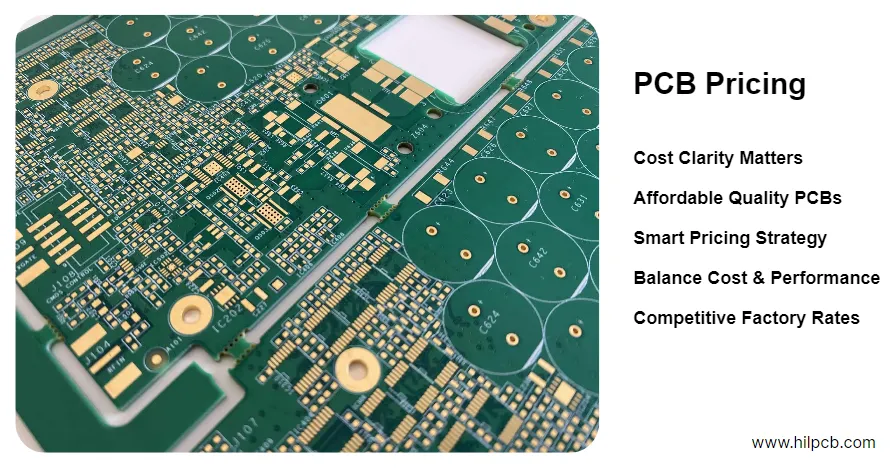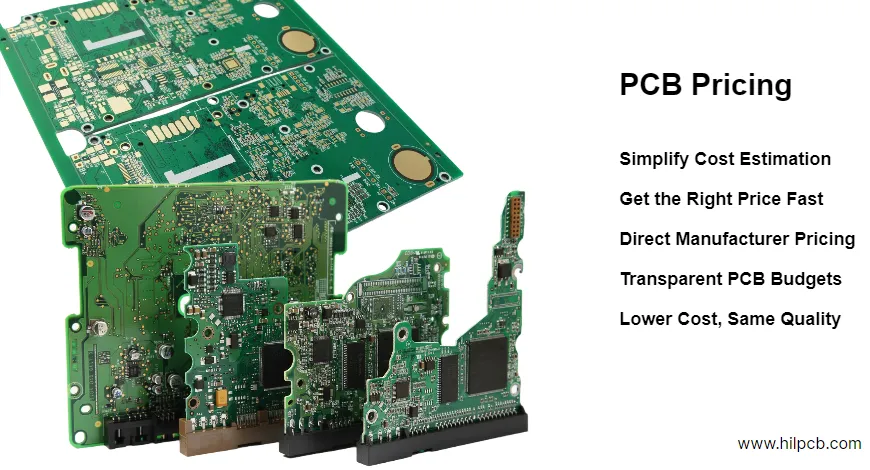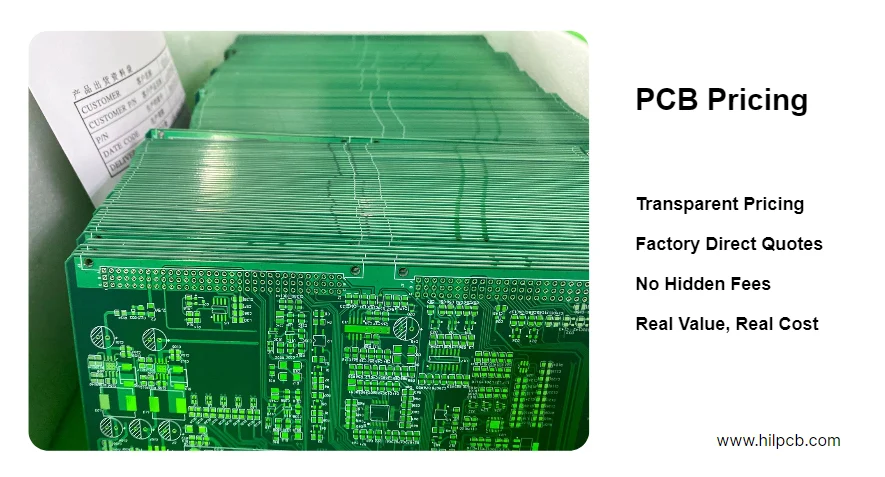Understanding PCB pricing is crucial for any business involved in manufacturing or procuring PCBs. Whether you’re designing a new product or scaling production, knowing how to calculate and optimize your costs can make a significant difference to your bottom line. In this guide, we will discuss the key factors that affect PCB pricing, the common pitfalls to avoid, and practical tips on how to minimize costs without sacrificing quality.
1. What Factors Affect PCB Pricing?
PCB pricing is influenced by several key factors that can significantly impact the overall cost of production. Understanding these elements is crucial for making informed decisions when ordering your PCBs.
- Board Size: Larger boards require more material, directly increasing costs. The size of the PCB also influences panel utilization, with larger boards resulting in higher material costs and more waste during production.
- Layer Count: The number of layers in a PCB determines its complexity. More layers require additional processes, longer production times, and increased costs. Reducing the number of layers in your design can lower manufacturing costs, but it’s important to balance cost and functionality.
- Material Choice: The material used in the PCB significantly impacts pricing. Standard materials such as FR4 are affordable and commonly used, but specialized materials like Rogers for high-frequency applications can raise costs considerably. Additionally, the thickness of the copper used in the PCB affects the cost—thicker copper layers increase both material costs and processing complexity.
- Surface Finish: Different surface finishes come with varying costs. The most economical option is HASL (Hot Air Solder Leveling), while ENIG (Electroless Nickel Immersion Gold) offers superior performance at an additional 8-12% cost. Choosing the right surface finish depends on your specific requirements for durability and performance.
- Assembly and Testing: Including assembly services and comprehensive testing adds to the overall cost. These services are essential for ensuring the functionality and reliability of the PCB, but it’s important to define your needs clearly to avoid paying for unnecessary services. For example, opting for basic testing rather than full assembly can help reduce costs.
By carefully considering these factors and making strategic decisions, you can optimize the cost of your PCB while still meeting your design and performance requirements.

2. How to Minimize PCB Costs Without Sacrificing Quality?
Lowering costs without compromising performance requires a strategic approach to PCB design and manufacturing. At HILPCB, we help clients find the right balance between cost efficiency and reliability through design optimization and production expertise.
- Design with Manufacturability in Mind: Many hidden costs come from designs that are difficult to fabricate. Keeping trace widths, hole sizes, and clearances within standard manufacturing capabilities eliminates the need for special tooling. Early DFM (Design for Manufacturability) checks can prevent costly redesigns later.
- Use Material Smartly: Choose materials that match your application — not every board needs high-frequency laminates. For most commercial or industrial applications, standard FR-4 offers excellent performance at a fraction of the cost of advanced substrates. Smart layer stacking and copper balancing also reduce waste and improve yield.
- Plan Production Volume Strategically: Instead of frequent small-batch runs, grouping production orders or forecasting demand can significantly reduce per-unit costs. At HILPCB, we help clients manage production schedules and PCB inventory efficiently to avoid setup costs and material shortages.
- Optimize Panel Layout: The way your PCB fits on a panel determines how much material is used — and wasted. Our engineering team uses advanced nesting algorithms to improve panel utilization, reducing scrap rates by up to 15–20% without affecting functionality.
By integrating smart design principles, material selection, and production planning, you can achieve measurable cost savings while maintaining high product quality.

3. The Pitfalls of PCB Pricing: Common Mistakes to Avoid
Even experienced engineers and purchasing managers can fall into hidden PCB pricing traps. These mistakes often lead to higher-than-expected costs, delivery delays, or inconsistent quality. By recognizing them early, you can make smarter procurement decisions and secure better value from your manufacturer.
- Overlooking the True Cost of Small Orders: Many buyers assume that smaller prototype orders are more cost-effective. However, each order involves setup fees, calibration time, and engineering preparation. When repeated frequently, these “hidden” setup costs can quickly exceed what you would spend on a larger batch. Planning ahead or grouping multiple designs into one panel helps spread fixed costs over more units — a simple step that can save up to 30%.
- Neglecting Lead Time Flexibility: Urgent delivery requirements are among the most common reasons for inflated PCB prices. Rush orders often force manufacturers to adjust production schedules, add labor shifts, or expedite material shipping. Unless absolutely necessary, choosing a standard lead time can substantially reduce your per-unit price. At HILPCB, our PCB lead time options let clients balance urgency with budget flexibility.
- Ignoring Manufacturability During Design: One of the most expensive mistakes occurs before production even begins — in the design stage. Designs that push the limits of standard fabrication rules (e.g., overly fine traces, exotic via structures, or unusual board shapes) demand special tooling and process adjustments. Conducting an early DFM (Design for Manufacturability) review with your manufacturer helps catch these costly issues before fabrication starts.
- Focusing Only on Unit Price, Not Total Cost: The lowest unit price doesn’t always mean the lowest overall cost. Quality inconsistencies, shipping delays, or high failure rates in testing can erase any initial savings. Total cost should include inspection, logistics, and after-sales support. Partnering with an experienced supplier like HILPCB ensures long-term reliability and transparency across the entire PCB logistics chain.
Avoiding these pitfalls isn’t just about saving money — it’s about building a sustainable production strategy. When pricing discussions include quality, lead time, and manufacturability, the result is a more predictable, cost-efficient process from prototype to mass production.
4. How to Get an Accurate PCB Quote: What Information You Need to Provide
A precise quotation starts with clear information. By preparing the following key details before submitting your request, you’ll ensure faster feedback and more accurate pricing.
- Production Files Include your Gerber files or other production data packages (e.g., ODB++), showing all layers, board outline, and drill positions. This enables our engineers to accurately evaluate your PCB layout and manufacturing requirements.
- Fabrication Requirements Specify your board parameters — such as thickness, layer count, copper weight, material (e.g., FR4 or high-frequency laminate), and surface finish (HASL, ENIG, ImmAg, etc.). If your design requires impedance control, special vias, or panelization, please include those details in your fabrication notes.
- Assembly Information (if applicable) For PCB assembly, provide a Bill of Materials (BOM) and component placement file. Clarify whether components will be supplied by you or sourced by HILPCB. This ensures a precise component cost and assembly schedule.
- Quantity and Lead Time Indicate your order quantity and target delivery schedule. We can optimize production batches and delivery methods to balance speed and cost according to your timeline.
- Testing, Packaging, and Logistics If you require electrical or functional testing, specific packaging (such as vacuum-sealed or panelized shipment), or designated carriers, please include these requirements when requesting your quote.
If you’re unsure which details are relevant to your specific project, our engineering team can assist in reviewing your documents and confirming the necessary information. We provide direct technical consultation to ensure your quote is complete, accurate, and ready for production.

